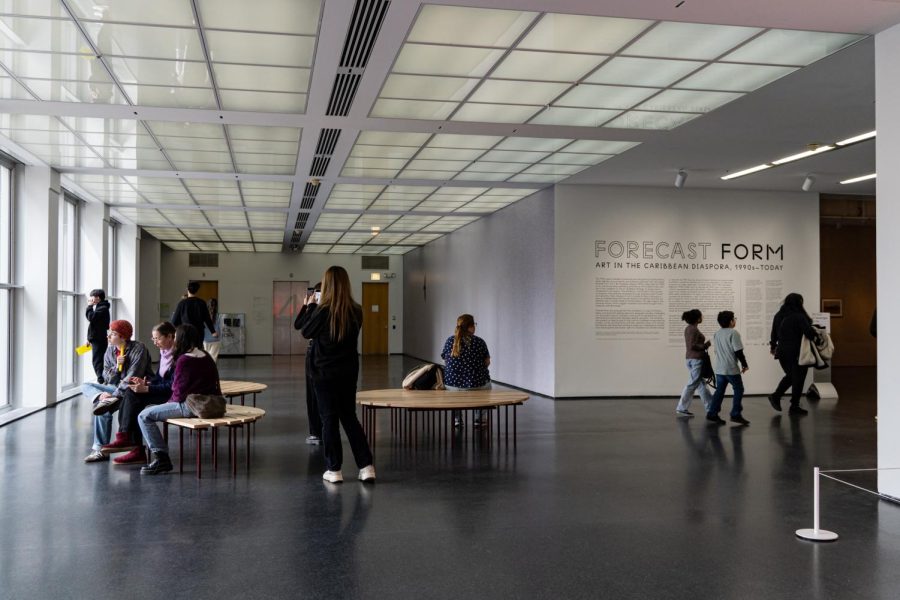MCA exhibit showcases exploration of home amid diaspora
March 31, 2023
Walking into the Museum of Contemporary Art’s new exhibit, visitors are welcomed by paintings, videos, sugar cane sculptures and a life-size palm tree.
Further into the exhibit visitors are greeted by two video panels, depicting well-dressed men operating gas lines like an old cowboy would throw a lasso. Titled “Gas Men” and created by Christopher Cozier, the piece “addresses the environmental impact of extractive oil economies as well as social conditions from centuries of colonial rule, enslavement, forced labor, and more recently, postindependence political corruption in Trinidad,” as written in his artist statement.
The exhibit, titled “Forecast Form: Art in the Caribbean Diaspora, 1990s-Today,” includes the work of 37 different artists. Curated by researcher and art critic Carla Acevedo-Yates, it opened in November of 2022 and will close in late April this year.
The Caribbean Diaspora goes beyond the strict definition of “diaspora” as a population of people living scattered across other nations and continents. There are many factors that play into the different diasporas, including colonization, resource extraction, forced migration to seek safety or find work, according to the Migration Data Portal. All are part of the history of the Caribbean diaspora.
In unison with the exhibit is a roundtable conversation held at the MCA between Acevedo-Yates and artists Cozier, Teresita Fernández and María Magdalena Campos-Pons. “One thing that I’ve been thinking a lot about—and that I’ve come to realize is the core idea of the show—is that the Caribbean experience, and Caribbean history, is crucial to our understanding of the modern world, past, present, and future,” Acevedo-Yates said.
After Acevedo-Yates asked the artists how they define the Caribbean, Campos-Pons reflected on memories of fried fish and plantain fries and the way small things like the smell of food brings her to the Caribbean—no matter if she’s there or not.
“This continuous rupture of feeling and sensing through space — of sensual and sensorial memory and experience — is, for me, one of the most profound definitions of the Caribbean, this lack of borders and ongoing extension through… a state of mind or; in a way, a state of being,” Campos-Pons told Acevedo-Yates.

One artist’s contribution to the exhibit is an immersive video installation. Artist Deborah Jack said she created the piece over several months; it includes archival documentary footage along with video she filmed at her mother’s home in Sint Maarten, officially part of the Kingdom of Netherlands, located in the Caribbean islands.
The muted sounds from the halls mix with the dim light to create a space that invites reflection. Crashing waves flow through the surround-sound speakers; close sights of warmed orange pomegranates fill the wall’s screens. The room is dark, only a couple of benches fill the open room.
“The notion of Caribbean Diaspora [to her] is always one of community,” Jack said. “I think of how I meet people who have a similar experience, culturally and geographically, and we find communion together… I think of the Caribbean as a fluid space that way.”
Jack spoke of the Caribbean as much more of a concept than a boundary of land, that no matter where you are physically, home can be found. “Yes [diaspora] comes from a notion of scattering, but it’s also people coming together… finding familiarity in foreign spaces,” she said.
“Forecast Form: Art in the Caribbean Diaspora, 1990s-Today” is on display at the MCA, located at 220 E Chicago Ave., until April 23. Students and faculty at Columbia College get free admission.








